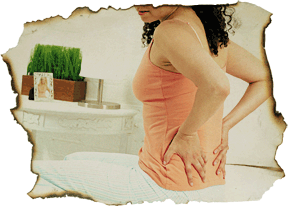Knee Pain
Why It Hurts: Are you feeling clicking and popping in your knee? Perhaps walking up and down stairs has become a challenge and taking those after-dinner walks is more and more difficult.
Knee pain can be a tricky condition because proper motion depends on the functioning of the hips and ankles. When you have pain in the knee, it can sometimes be difficult to do direct exercises for rehabilitation. That's why you are going to work on moving the ankle to help the knee. Why? If the ankle does not move well enough, your body overuses the knee every time you take a step and it can become painful.
What You Can Do: Stand on the edge of a step with the balls of your feet. Make sure you have something to hold on to for balance. Keep a slight bend in your knees and let your heels drift downward towards the floor, so your toes are higher than your heels. Sink the heels downward as far as you can and hold for 5 seconds. You can progress to one foot at a time for increased intensity. Return to the starting position and repeat 10 times. For even more intensity, hold a dumbbell in front of your body. The additional weight increases motion in the ankle joint. (Note: There should be no "pinching" sensation in your ankle.)
Shoulder Pain
Why It Hurts: You love playing a game of catch with your kids in the backyard. Every weekend it's a ritual to toss the baseball around and spend quality time. But lately, you can't throw without getting shoulder pain every time you raise your arm. What could it be? When it comes to shoulder pain, there are many different areas of the body can be involved, so an evaluation by a health care professional is encouraged. Every shoulder problem is related to how well you move in your mid-back. There is an intricate relationship between the motion of your thoracic spine (mid-back) and your shoulder.
What You Can Do: Here is a very effective exercise you can do at home or in conjunction with your rehabilitation program to speed up your recovery. Increase rotational movement in your mid-back to help your shoulder move better. Lie on your left side on the floor with knees tucked high in a fetal position at waist level. Use a pillow for head support to relax muscles in the neck. Makes sure your shoulders, knee, and ankles are stacked on top of each other to prevent twisting in the lower back. Extend (straighten) both arms out in front of your body along the floor, with palms facing each other. Take your right arm and rotate (turn) it behind your body, trying to touch the back of your hand to the floor behind you. Turn your eyes and your head to look behind in the direction you are turning. Do not let your knees separate, and keep your left arm on the floor. Return to the starting position. Exhale on every reach backward. Do 10 repetitions and repeat on the other side. You should feel this in the upper back and chest region.
 Lower Back Pain
Lower Back Pain
Why It Hurts: The thought of getting out of bed in the morning makes you cringe. The very act of sitting up sends an intense ache into your lower back. You think, 'How can I even work today? 'How am I even going to brush my teeth?' Lower back pain affects 80 percent of Americans and even with rehabilitation, it is still very susceptible to re-injury.
What You Can Do: One of the most powerful ways to help your back is to help your hip joint move more. When you lose motion in your hip, it forces the back muscle to work more in an effort to compensate. So in reality, your back muscles are simply overworking and they need to rest. Lie on your back with your knees bent and feet flat on the floor. Keep yours arms by your side with palms up. Move both feet 6 inches away from the body and make sure they remain flat. Your feet will no longer be in line with your knees. It will look like a wide-stance position. Keeping feet flat on the floor, bring both knees inward, trying to touch them together (knock-kneed position). Hold for 2 seconds, separate knees, and then repeat 10 times. Move the feet further apart when it gets easy to perform. You should feel this in the outside of the hips.

